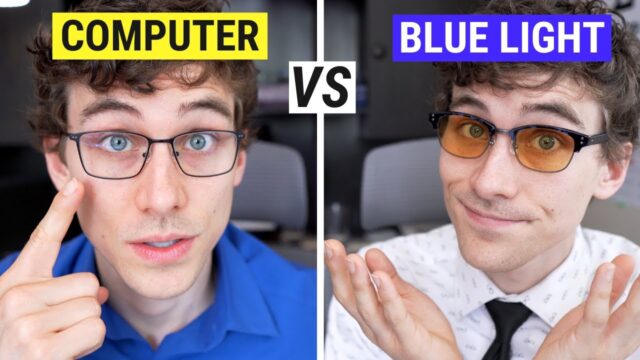
If you’re someone that spends a lot of time in from of a screen, whether it’s a computer screen or a phone, you may have experienced some eye strain and thought about getting a pair of protective glasses. However, if you’re not familiar with the terminology and the technology behind these glasses, you might be confused with all the different types of glasses that are available.
One of the most commonly advertised protective lenses are blue light and computer light and many wonders – is there an actual difference between the two or are they one and the same? Well, we’ve decided to help you with that dilemma. Today, we’re going to take a look (no pun intended) at both and show you the differences, so, if you do decide to purchase a pair, you can make an informed decision. Let’s get started.
What Are Computer Glasses?

To start this off, we’re going to talk about computer glasses first. These are exactly what they claim they are – a pair of protective eyewear that protects your eyes from the light emitted from a computer or any other digital screen. You notice we did not which light precisely, because, as research shows, blue light isn’t the only thing that’s harming your eyes when you spend a lot of time in front of a screen. We’ll touch on that in just a minute.
What Are The Usual Eye Problems Caused By A Digital Screen?

To better understand the differences between these protective lenses, let’s first take a look at an array of issues one might suffer from prolonged exposure to screen light.
- Blurred Vision
- Watery Eyes
- Headaches
- Dry Eyes
- Eye Itchiness
- Fatigue
- Inability To Fall Asleep
These are only the most common symptoms or problems associated with a digital screen, but there are a few others, as well.
The sad part is, we’ve become dependent upon our electrical devices. We use them for both work and fun and when you take than into an equation, you’re looking at around 10 hours of screen-time every single day. As you can probably imagine, this is not in any way healthy, but, that doesn’t mean we can’t do something about it.
How Do Computer Glasses Work?

First of all, we have to keep in mind that there is no industry standard as to what a pair of these goggles need to do or have, so the term ‘computer glasses’ may refer to a lot of different things. With that in mind, unless they filter out the blue light – they should not be categorized as computer glasses.
Blue light is not the sole culprit when it comes to eye strain and damage, but it is the main one. Most damage to our eyes is done by the blue and turquoise light (400-495nm wavelength) emitted from the screens. This occurs because this wavelength carries significantly more energy than the rest, thus straining our eyes to a greater extent and causing all the aforementioned issues.
Therefore, a pair of protective computer goggles must have a blue light filter, otherwise known as blue-cut, that will filter out the entire wavelength range (400-495nm) of blue light. Now, if you’d like a better, in-depth explanation of the filtering process, you may click here.
In addition to that, a quality pair of computer glasses will also come equipped with slight magnification and anti-glare coating. Also, it is important to mention that these glasses should be prescribed by an ophthalmologist that will first examine your eyes and prescribe the best lenses. However, they are also safe to be used without a prescription, as well.
What Are Blue Light Glasses?

There are two types of blue light glasses – daytime and night-time. Daytime glasses are clear and they are what many consider computer glasses, as they work in the exact same fashion as the ones we’ve previously mentioned.
On the other hand, night-time blue light goggles are tinted – usually red or orange. Night-time type filters out the entire blue light spectrum and they are designed to be worn at, you guessed it, night. These aren’t meant to be used in front of a display, rather they’re there to protect us from all the blue light once the sun sets, as any exposure to it during night-time can affect our ability to fall and stay asleep. These tinted lenses make sure none of it goes through, so you can easily fall asleep once the time comes.
These can also block the green light, up to 550nm wavelength, so before you decide to purchase a pair, make sure you check the spectral test reports, so you’re certain they actually do filter out the wavelengths they claim they do.
What Are The Differences Between The Two?

Well, now that we’ve covered the basics of these two – let’s take a look at the differences. As you can clearly tell, there are a few, but they aren’t, in fact, that different.
The main difference lies in the fact that the blue light glasses are designed to be used both at day and night-time, opposite of the computer goggles. Additionally, blue light glasses offer just one thing – blue light protection – nothing more, nothing less.
On the other hand, a pair of quality computer glasses will offer not only blue light filtering, but they’ll also come with anti-glare coating, decentred pupillary distance and slight magnification. With this in mind, it’s clear that the primary focus of these glasses is to reduce digital eye strain or DES, not only to filter out the blue light.
No one understands that better than Muunel. Two friends who have for years suffered from eye strain decided to put all of their knowledge and skills together and create a quality product to help others who suffer from the same issue.
In conclusion, you could say that all computer glasses are blue light glasses, but not the other way around. We feel like that’s the best way, to sum up, the differences and similarities between the two. Hopefully, we’ve managed to help you understand what each of these is and what are their strengths.







